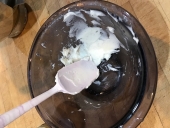Thank you for the kind words about my book : )
What is the difference between Havarti and Gouda? You list both on page 98 but I can't see where one is differentiated from the other. Which makes me think, "does it really matter?”
It’s hard to say - it’s not possible to go back in time and find out for certain how each one was originally made. Looking at modern cheese recipes, sometimes Havarti will start off washing with cool water, before being heated, and sometimes it is made in a similar way to Gouda, which is washed with warm water, heating it up at the same time. Havarti is usually pressed with less weight, but I just press both cheeses with minimum weight as I prefer the texture of it that way. At the end of the day, whatever you make with this style is just going to be a lovely mild cheese. Gouda is generally aged a bit longer than Havarti, but you can eat a Gouda when it’s young or a Havarti when it’s older and it doesn’t really matter.
On these pages of my book there is a “cool water Havarti” variation, the results of this turn out much the same as Gouda, but it’s worth trying sometime if you’re interested in noticing the differences in the cheesemaking process.
I want to make ALL your cheeses. Since I am having a hard time finding anyone who is nurturing kefir grains (sure I could order them, but I'd prefer to find some local) I have been using purchased cultures in my cheesemaking for the past year. Can I use an equivalent amount of culture to your kefir...meaning, I have been using 1/8tsp MM100 Meso culture to 2 gallons Nigerian Dwarf goat milk for my cheddar. Your cheddar recipe has 1/3 cup kefir to 6qts milk, so let's round that to...1/2 cup kefir (okay its really .444 cup) for 2 gallons milk. Can I sub culture at this comparative amount for any of your recipes?
I think ordering kefir grains online is a worthwhile thing to do if you can’t find them locally - when I ruined my last batch and wasn’t in contact with anyone local that had them anymore I ordered some from an eBay seller and am very happy with this latest batch.
If you want to use dried cultures for my 6 quart recipes, I would recommend scaling up or scaling down the whole recipe, to make it from 1 or 2 gallons instead, rather than adjusting the culture amount - too much of the commercial cultures could result in bad flavours.
What is the best whey to use for gjetost? Different wheys from making the different cheeses make a different tasting gjetost. The most phenomenal gjetost I made was when making a cambazola but that cheese recipe used 2 qts of cream in addition to the milk so I think that is why it turned out sooooo fudgey creamy.
My family are obsessed with gjetost, so I just make it from every bit of whey that I can. Traditionally, the Jarlsberg/Alpine types would be used for this the most often - they have minimal acid buildup during the cheesemaking process, which results in a sweeter whey, but any cultured whey will also go well, except for chèvre types, which will be too acidic.









